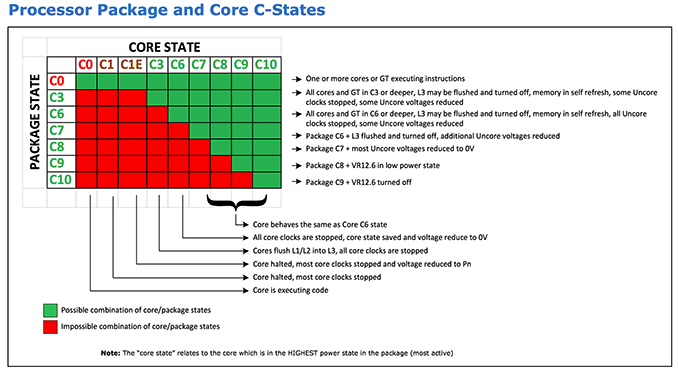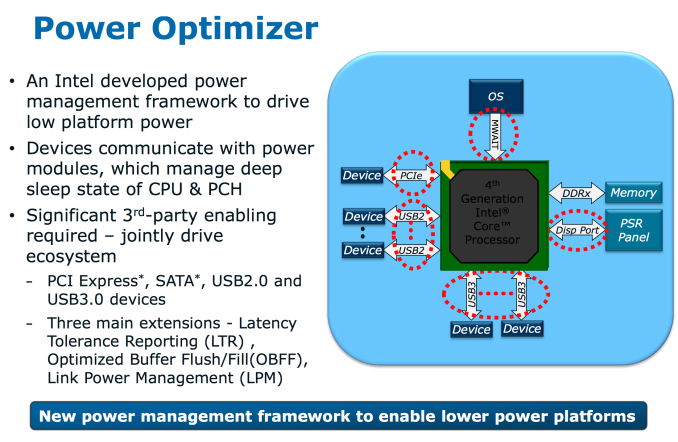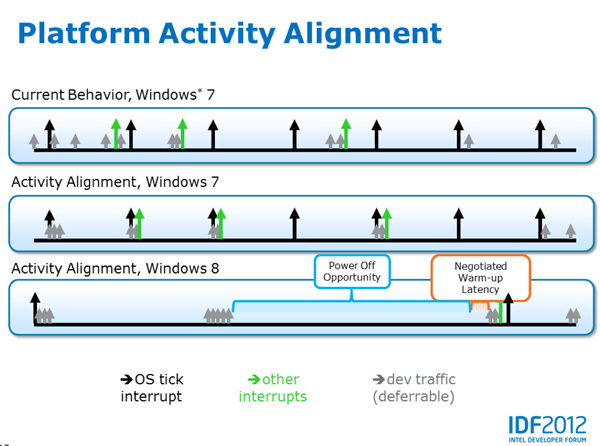The Haswell Ultrabook Review: Core i7-4500U Tested
by Anand Lal Shimpi on June 9, 2013 9:00 AM ESTHaswell ULT: Platform Power Improvements
Over the past several years, Intel’s maniacal focus on reducing CPU power almost entirely ignored the rest of the platform. Even its own chipsets were often on high power process nodes (remember the first Atom’s 2.5W TDP, but with a 6W chipset TDP). This all changes with Haswell, at least with the ULT/ULX flavors.
I already went through the chipset/PCH changes. The move to 32nm and bringing the PCH on-package will help with power tremendously. But with Haswell, Intel looked beyond its own silicon to other controllers on the motherboard for opportunistic power savings.
With Haswell, Intel deploys its new platform power management framework called Power Optimizer. Its goal? To deliver S3 (suspend to RAM) style power savings, at S0 (active) style latency.
On the CPU, Intel had to dramatically increase its ability to turn blocks on/off, as well as quickly enter/exit its own low power states. Haswell’s FIVR (Fully Integrated Voltage Regular) helps tremendously in this regard as it can quickly switch between voltage states (Intel claims 5x - 10x faster than off-package VR). Haswell as a result can more aggressively choose to go down to lower power states because it can come out of them very quickly. Haswell ULT/ULX support lower core and package C-states. The entire SoC can now be power gated in C10, where the rail that feeds FIVR can be shut off.
For the rest of the platform though, Intel did what the PC industry is best known for: designing a spec and asking others to implement it.
PCIe, SATA, USB 3, DisplayPort are all touched by Power Optimizer. Devices on these busses can report latency tolerance to the PCH (how long can I sleep without breaking everything), and based on that information the PCH can determine how frequently everything has to wake up to avoid impacting user experience.
Haswell will take all of the latency tolerance information into account and coordinate system wide sleep/wake based on the least common denominator. The idea is that during idle periods, there’s no reason that most of the platform components can’t be driven down to their lowest power states as if your notebook lid was shut; especially as long as they can quickly wake up when needed. Intel calls this platform level active idle state S0ix, and it’s only supported on Haswell ULT/ULX. In the past Intel had referred to multiple S0ix states, but it looks like Intel is trying to move away from that nomenclature. Effectively now there’s just S0 and S0ix in terms of active power states.
Obviously all it takes is a single 3rd party component to ruin everything, so Intel has worked with device and microcontroller manufacturers to help improve their power profiles as well. Intel’s Power Optimizer architecture is very robust. Intel plans on working with platform vendors regularly to improve power. There are no more easy power gains; going forward, reducing power is going to require a much more collaborative effort from all the power consumers on the platform.
Windows 8 also plays a significant role in all of this as the OS supports coalescing of tasks in software to ensure that it isn’t working against Intel’s Power Optimizer in hardware.
If the CPU/SoC and much of the motherboard can aggressively drive down to S3-like idle power, the display becomes an even bigger burden than it has in the past. To allow the entire platform to go to sleep while the display is still active, Intel recommends Panel Self Refresh (PSR) to be implemented in Haswell Ultrabooks. The idea behind PSR is to put DRAM on the panel itself to store the frame buffer. In the event of a static display (e.g. staring at a Word document, looking at your desktop), the GPU frame buffer is copied to the panel’s DRAM, and the GPU itself is shut off instead of having to drive meaningless content updates to the display 60 times per second. With PSR, the SoC can go into its deepest sleep state (C10).
No Connected Standby for Now
Although you should be able to realize some of the benefits from S0ix with the first Haswell Ultrabooks, Connected Standby (periodic content refresh while in a sleep state) requires OS support. For Haswell Ultrabooks, that means waiting for Windows 8.1.
Even on the S0ix side, it’s not clear to me whether all of the devices in the system capable of going into D3 (their lowest power state) while active will actually do so until Windows 8.1. I get the distinct impression that Haswell Ultrabooks will see a tangible increase in battery life with Windows 8.1.













87 Comments
View All Comments
Freddo - Sunday, June 9, 2013 - link
I wonder if this CPU is powerful enough to run the PS2 emulator PCSX2 well, it require a somewhat decent CPU.bakedpatato - Sunday, June 9, 2013 - link
So the M series socketed Mobile Haswells are not getting S0ix?stevechippy - Sunday, June 9, 2013 - link
Correct, but there are U-series 28W TDP parts that aren't in the Ultrabook bracket AFAIK.Kevin G - Sunday, June 9, 2013 - link
Typo on page 7 on the Tomb Raider 1600 x 900 test graph: "Motion Blue".http://images.anandtech.com/graphs/graph7047/55515...
Ryan Smith - Monday, June 10, 2013 - link
Thanks!name99 - Sunday, June 9, 2013 - link
"The shift of consumer dollars to smartphones and tablets instead of notebooks and desktops won’t be reversed, but a good launch here might at least help keep things moving ok until Silvermont, BayTrail and Merrifield can show up and fill the gaps in Intel’s product stack."I love you Anand, and I love your tech analysis. But it might be worth your team acquiring a business analyst, or at least asking those sorts of questions of your informants.
Silvermont does not "fill the hole in Intel's product stack" because that hole is business-based not tech-based. We saw the prices of Haswell a few days ago --- $250 and way up. Meanwhile the price of a high-end ARM SoC is, what, $20? That's one hell of a difference.
The problem intel faces is that, for many purposes, it's perfectly adequate to pay for the $20 ARM CPU rather than the $250 Intel CPU. Silvermont and the whole Atom strategy, rather than making things better make things worse. Yes, now maybe Intel captures $20 from sale of an Atom --- but that Atom is ALSO able to replace Haswell (or at least lower-end but still more expensive Intel CPUs). The SMART Intel strategy would have been to acquire an ARM ISA license, making competitive ARM CPUs at $20 (so you still capture from that market) but at least avoid competing so directly with your more expensive line.
Intel's problems from here on out are business problems. They have to compete with an architecture that is simple enough that Apple could put together a competitive CPU starting from scratch in two years, and they have to do so using an architecture that is so complicated it took Intel 5 years to out together a competitive CPU. Meanwhile they can't charge Haswell prices to maintain the massive parallel design teams that are required to create these ever more sophisticated x86 designs.
(And, to make life even worse, apart from the myriad own goals Intel has inflicted, they have MS in the background insisting on its charges for Windows x86, one more drag on the sale x86 in the tablet market.)
I don't think things are nearly as rosy for Intel as do you. Technically yes, they are well-positioned right now. But they seem to be in the position of DEC or IBM in the early 80s --- technically superb, but with an extremely problematic business model. And it's business model that determines the future, more than technology...
rwei - Sunday, June 9, 2013 - link
IIRC Intel does have a full ARM license. But supporting ARM by making ARM parts competitive with Intel's x86 ones would be a blow to their future ability to extract economic rent for x86, as more software targeted at ARM became available.Much preferable to decisively beat ARM for 1-2 generations with x86 parts - if they can manage it.
peterfares - Monday, June 10, 2013 - link
ARM is going to keep getting better and better with or without Intel. It might be smart for them to have the best ARM chips because then they'd get the money from people buying ARM chips. Not too much better than the rest that it impacts their x86 chips though. Either way, I'm glad that we can get affordable x86 computers. Until Android can truly compete with Windows on the bigger screens I'll stick with x86 Windows. Android is a LONG ways away from being able to replace Windows for me. Intel is in a tough position though.meacupla - Monday, June 10, 2013 - link
The main short comings with ARM are the lack of processing power and the massive power consumption increase with faster chips. These chips are good enough for a majority of users and the OS' that run on them support just enough games and programs to keep those users happy.Intel, on the other hand, have chips that are fast, but need to get their power consumption and heat output lower. There's no shortage of games and programs that only run on x86, so if you need to run a specific program that won't work on ARM, your choices become quite limited.
Amagus - Sunday, June 9, 2013 - link
Is the increased battery size without increasing size/weight of the system a result of a better battery/design by Acer, or is it directly influenced by Haswell (eg lighter/smaller platform)? I noticed the thing happened with the Sony Vaio Duo Haswell design...they stuck in a bigger battery (in addition to a bigger screen) but it's weight barely went up to.